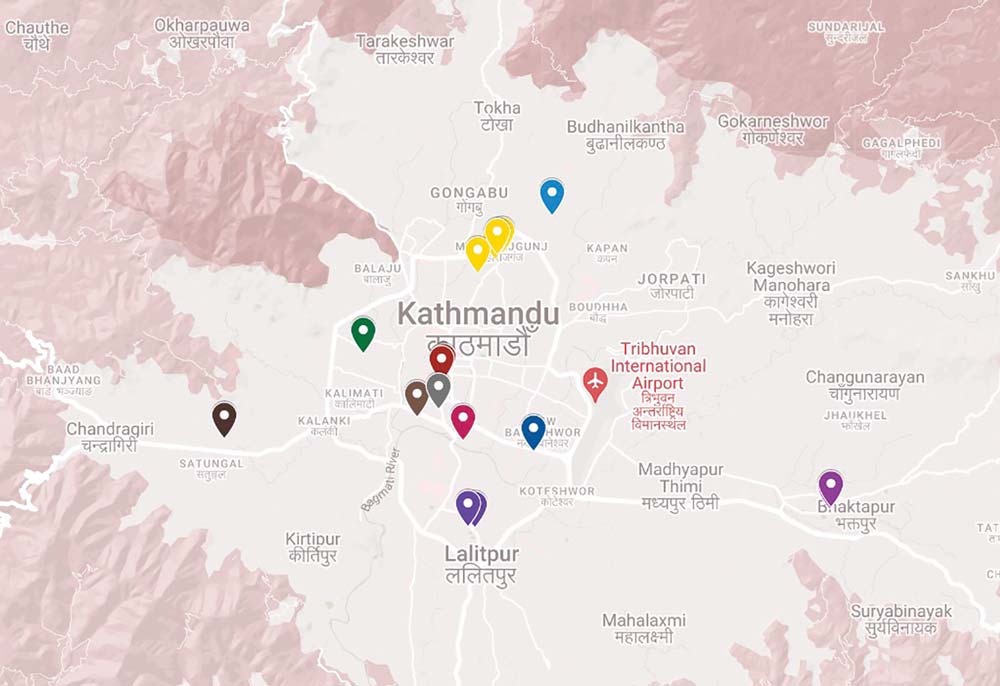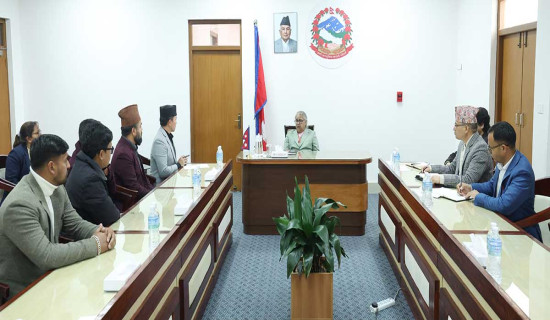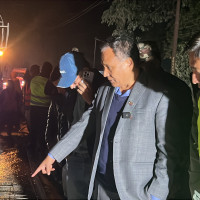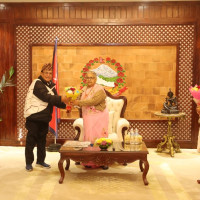- Sunday, 21 December 2025
MoHP and NIC set to collaborate to tackle hospital equipment woes
Kathmandu, Sept. 8: It is not something new for Nepalis to find health services suspended in government health centres due to problems such as dysfunctional health equipment and a lack of medical instruments, manpower and medicines.
The issue permeates the entire government health system, from primary health centres to tertiary hospitals. However, as long as insufficient budget is allocated for health infrastructure, equipment and manpower, the problems will continue. Making government health centres and concerned authorities free from irregularities, retaining health manpower and restoring medical education’s quality are other major challenges.
Thus, Nepal’s health sector demands major reforms in several areas for the State to ensure, as stated in Article 35 of the Constitution of Nepal, every citizen has the right to free basic health services and no one is deprived of emergency health facility.
While it may take some time to provide every citizen with equal access to health services under the State’s limited resources, some government health centres and their staff have, on many occasions, regenerated the public’s faith in government health institutions.
Meanwhile, in a bid to add another stone towards the betterment of the country’s health sector, the Ministry of Health and Population (MoHP), under new leadership of Minister Pradip Paudel, has taken a step to prevent the disruption of health services in government health centres due to defective health equipment. For it, the MoHP has signed an agreement with Mahabir Pun’s National Innovation Centre (NIC).
Pun, who was travelling across the country selling his biography to raise funds for the Birgunj-based state-owned Krishi Aujar Karkhana, arrived in Kathmandu on August 21 to sign the agreement. As per the agreement, the MoHP gave the NIC the responsibility to repair health equipment in 17 tertiary hospitals of Kathmandu Valley under the federal government.
“The 17 hospitals can coordinate with the NIC based on the agreement and under prevailing laws. This step also allay criticism that the government only tries to buy new equipment,” said Dr. Prakash Budhathoki, spokesperson for the MoHP.
Condition of health equipment
Once in a while, the government assists a handful of hospitals with major equipment worth millions of rupees. It is why Nepali government hospitals are capable of performing major surgeries and operations, from advanced cancer treatment to transplanting kidney, liver, heart and bone marrow.
For instance, around 10 days ago, Bhaktapur Cancer Hospital expanded its services in radiotherapy through an advanced 256-slice CT Scan machine provided by the MoHP. Minister Paudel had inaugurated the machine and pledged to make hospitals equipped with necessary equipment allowing insured citizens to utilise the government’s health insurance services to the utmost.
However, the same hospital, on August 16, issued a notice. It called for interested companies with a 1.5 Tesla Machine as the hospital needed to outsource MRI services to facilitate patients, insured under the government’s health insurance scheme, arriving at the hospital’s Radiology and Imaging Department.
On the other hand, major hospitals have several advanced equipment gathering dust after technical defects and a shortage of manpower to repair them.
‘Biomedical Equipment in Nepal's Public Health Institutions’, a joint study by the MoHP’s Department of Health Services (DoHS) and Lifeline Enterprises conducted in 11 tertiary hospitals of Bagmati, Koshi, Madhes, Gandaki and Sudurpashchim provinces from October 2023 to April 2024, has shown that the situation is dire.
“Out of the 19,174 pieces of equipment surveyed in the 11 hospitals, 1,074 pieces were in good condition but were unused while 1,823 equipment were lying dysfunctional,” the study found.
Revealing the findings in May, Bhaskar Rijal, a biomedical engineer involved in the study, said, “CT scan machines of Bir Hospital, APF Hospital and Koshi Hospital have turned worse with severe complaints about the charger board and battery.”
During the same event, Bir Hospital’s Director Dr. Santosh Poudel said that the country’s oldest hospital did not have biomedical engineers to look into the technical problems in major equipment as the 370+ bedded hospital only had biomedical technicians.
The lack of vacancies for biomedical engineers in tertiary hospitals has not only disallowed hospitals from repairing their equipment, they are not maintained regularly as well. “Medical equipment, without regular maintenance, also stop providing proper results,” health experts stressed.
“This shortfall poses notable risks for patients and healthcare workers because radiation safety, quality systems, and maintenance are inadequately guaranteed… The rapid evolution of technology for imaging involving radiation exposure poses challenges to maintaining the safety of patients and healthcare workers because this maintenance requires the education and training of health professionals and regulatory staff; moreover, the rapid evolution of this technology makes it challenging to keep regulations up to date,” read a 2021 study titled ‘Medical imaging and nuclear medicine: a Lancet Oncology Commission’ published in The Lancet.
NIC’s plan
The National Innovation Centre (NIC) is not debuting in the medical sector. The Centre’s Nyano Nani (Baby Warmer) project, an innovative biomedical equipment designed to provide the necessary warmth that a newborn baby requires at crucial times, is a major example.
Similarly, the NIC’s activeness during the COVID-19 pandemic cannot be forgotten. Pun’s NIC produced respirators for doctors/nurses and patients in ICUs, isolation hoods, body bags, aerosol and isolation boxes, masks, nursing robots and corona booths, among others, to support the country’s fight against the pandemic.
Likewise, NIC’s biomedical engineering team supported the health sector with another major favour: repairing dysfunctional equipment.
“The NIC coordinated with the Nepal Biomedical Association and created a team of volunteers of biomedical engineers and sent them to different hospitals. We found that there were 85 broken ventilators and 24 kidney dialysis machines... More than 42 ventilators and 18 kidney dialysis machines have been repaired so far and are ready to be used by hospitals,” read an article ‘Our fight against COVID-19’ by the NIC in March 2022.
“By the end of the pandemic’s serious foray, we had repaired more ventilators and dialysis machines. Then, we found that many machines had basic defects related to bulbs, fuse and wires, and they were repaired easily.
Some repairs required major spare parts, and finding them was a herculean task,” said Er. Umesh Ranjit, team leader of Biomedical Engineering at the NIC.
According to Ranjit, the NIC currently has 15 biomedical engineers, including six interns with plans to add more as per the necessity. “We will first reach individual agreements with the hospitals. Our work will then begin in three phases,” he said.
“Inventory listing is Phase 1. In this phase, we list available equipment through a software created by the NIC. In Phase 2, defective equipment will be segregated and analysed. Repairs will take place in the third and final phase,” Ranjit told The Rising Nepal.
After the agreement with the MoHP, the NIC was reached out by Kanti Children’s Hospital, Bir Hospital and Bhaktapur’s hospitals for coordination. “We have signed an MoU with Bir Hospital. We are beginning Phase 1 there. Further discussions with Kanti and Bhaktapur are underway,” said Ranjit.
As per the agreement, the hospital should manage spare parts, and if they are expensive or difficult to procure, the MoHP will tend to the issues.
Expectations high and low
Both stakeholders, the MoHP and the NIC, have put great faith in each other while signing the agreement to repair and restore malfunctioning equipment in the federal hospitals of the Kathmandu Valley.
“I believe Mahabir Pun, who has been exploring possibilities to utilise domestic resources and skills within the country, will fulfil the responsibility that is in line with his aim,” Minister Paudel posted on his Facebook on August 21 while revealing the signing of agreement with Pun.
MoHP spokesperson Dr. Budhathoki said, “Pun and his NIC is a centre of trust. Thus, the MoHP has expressed full backing to the initiative.”
While the government has put its faith in the NIC, Pun is not expecting a lot.
“A glimpse of today's meeting at the Health Ministry. The responsibility to care biomedical machines of 17 federal hospitals has been taken up by the National Innovation Centre.
We hope the ministry will not disappoint us as we suffered with the Birgunj Krishi Aujar Karkhana,” Pun wrote on his Facebook while sharing a video of the agreement signing ceremony on August 21.
According to Pun, the step was highly ambitious and, if everything went fine, beneficial for the general public.
“We have demanded the biomedical engineers be provided with lodging and food alongside minimum wage by the respective hospitals. If the authorities backed away, we can do nothing. If the authorities support us, we can do many things,” Pun told The Rising Nepal.
















